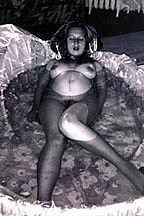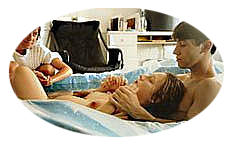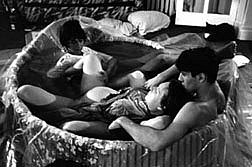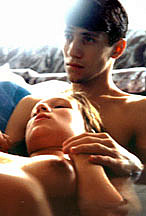 |
HERSTORY OF WATERBIRTH
METOLOGY: the science of taking two completely different elements, copper and tin, creating a third substance known as bronze, an element that changed civilization as we know it. That’s what man, woman, child is; changing civilization as we know it with each and every birth.
WATER is the cradle of life here on earth. Seventy percent of the earth is water, 90% of a newborn’s body is water, 60% or an adult’s body is water. Life originated in the ocean more than 3 billion years ago. In the warm seas, the first primal creatures were developed, grew and multiplied. Some evolutionists believe we emerged from the depths of the sea millions of years ago.
Our first 9 months of life took place in the womb of waters. Sounds of the ocean’s waves simulate the blood rushing through the placenta.
By observing that moist nature was in the seeds of everything, Aristotle, in the 6TH century BC, concluded water was the first principle of life. It is the most precious of our natural resources…it maintains life. Water’s qualities are innumerable as it holds hot, cold, it conducts, transfers, absorbs temperature and calms the spirit.
In the 1700s, scientists begin to understand and identify the properties of water also its value as a form of hydrotherapy. "Water Cures," a book printed in London in 1723, describes the benefits of water used for all conditions, including labor and birth.
It has been researched, Egyptians birthed selected babies underwater. It is believed these babies became priests and priestesses.
Minoans on the island of Crete are said to have used a sacred temple for waterbirth.
In the Minoan ruins, art on frescoes reflect dolphins and the special connection with humans and water.
The Chumash Indians of California have told stories about women laboring in pools and shallow inlets along the beach while the men of the tribe drummed and chanted. In his nineties, Grandfather Semu, a Chumash elder remembers when he was a boy how women would often go to the beach and labor in shallow water. He also remembers dolphins appearing nearby and staying close to the women until the baby was born.
Indian tribes in North, Central and South America as well as the Maoris of New Zealand and the Samoan People of the Pacific have been known to birth in shallow ocean and river environments.
Kuhuna’s, from the Hawaiian Islands state thousands of generations have been born underwater.
The first recorded modern waterbirth took place in a village in France in 1805 and detailed in a French medical society journal reporting, through the suggestion of her doctor, a woman who had labored for 48 hours received temporary relief, from her non-progressing labor in a warm bath. After a short time in the tub, the baby came out so quickly that she didn’t have time to leave the water to birth her child.
Subsequent reports of water birth were scattered until 1960s when documentation of water births began in the Soviet Union.
The '60s, the decade when the head met the heart and redefined a balanced individual to mean, one who operates with heart and mind in unison.
Thus begins the work of Igor Charcovsky, a self-educated Russian scientist and healer who researched animals laboring and birthing in water. His work involved observation of babies in water, including his daughter Veta, who was born prematurely in 1963, weighing 2.62 pounds. Charcovsky placed his daughter in a water environment, a shallow pan of warm water for most of the first two years of her life. Igor rationalized the benefit of his daughter not having to combat gravity while in the water and thus conserve the energy to vital organs to survive as opposed to an incubator in gravity in a hospital.
At the same time Igor’s work was being done, Frederick Leboyer was introducing the concept of a warm bath for the baby after the birth, in a hospital located in a small suburb of Les Lilas. It certainly introduced a less violent approach to coming into the world, yet the drawback was taking the baby away from the mother at birth. Now in some hospitals or birth centers, there is a permanent tub installed for the women to optionally labor or birth in.
Midwives at hospitals observed a difference in the babies born in the water as opposed to the air. "We can tell which babies have been born in water. They are like little grown-ups. You know they understand you. It’s very special to be with them."
In the early '70s, Dr. Leboyer had become a friend of Dr. Michel Odent, formerly head of surgery at a hospital in Pithiviers, France. Odent was the first physician to recognize the beneficial effects of warm water for labor and birth. Dr. Odent coined the term: "fetal ejection response," where women suddenly have an urge to leave the water. As they enter the cooler temperature and the change triggers an adrenaline release as the baby emerges out of the mother very quickly. Similar to the "milk ejection reflex," when a mother hears her baby cry, or sees the baby across the room or even thinks about the baby and milk slips out of her nipples ready to feed the baby. If we can learn to become more respectful and aware of the miracle of our biology, the whole process of pregnancy, labor and birth might be that much easier.
In the early '70s the practice of lay midwifery reemerged in the US, mostly in northern California and Boston area. By 1981 a small group of midwives heard about Odent and Charcovsky’s work.. The practice of "Rebirthing," a technique developed in the '70s as well for tapping into repressed emotions and memories, including memories of one’s birth. Rebirthing couples began to birth their babies in water. Some were attended by medical caregivers and others weren’t.
 |
Karil Daniels, an independent filmmaker, began her pioneering research on underwater birth in 1981. That work led several years later to the multiple award-winning WATER BABY documentary, which was shot in three countries and brought together the world's leading pioneers in one comprehensive program that demystified this new method and motivated hundreds of birthcare providers and facilities to make it available to their patients. This tape remains, years later, one of the most comprehensive videos available on the topic and is now widely used by both birthcare professionals and parents seeking to educate themselves and their birthcare providers on the topic. To get more details regarding this video, Click Here.
On February 2nd, 1982, the first "Homo Delphinus Conference," was presented in New Zealand and produced by Estelle Myers, a waterbirth activist, dolphin lover, ecofeminist and peacemaker. 'Homo Delphinus,' the human dolphin, water babies, was coined by the infamous deep sea diver, Jaques Mayol. In January 1986 Estelle Myers again produced the second "Homo Delphiuns Conference" with Jaques Mayol as the key note speaker at both. Estelle, assisted the first underwater birth on the 17th of March, 1982 in New Zealand. She's produced a number of videos and become an international speaker on the dolphin and human connection.
In 1985, The Family Birthing Center in Upland, southern California headed by Dr. Michael Rosenthal offered women the possibility to labor or birth in water. After five years and extensive accumulation of experiences of water birth, by 1993, almost 1000 births later, no complications or infections of mothers or babies Rosenthal quotes, "At the Family Birthing Center, we feel strongly that woman are giving birth. They’re not coming here to have their babies delivered. Part of our effort is to restore control of birth back to women. We take the term ‘nonintervention’ in a very literal sense. It often means that women give birth without me using my hands. The use of warm water for labor and birth might be viewed as radical and new in the human experience, however, from a historical perspective, the use of most obstetric interventions such as spinal or epidural anesthesia, narcotics and forceps are comparatively recent. The use of water should be one of the most risk free interventions. If the bath had been used earlier in this century, we might never have passed through the era of ‘twilight sleep’ sedation that depressed babies and removed mothers from the conscious participation in birth." - (Excerpt from the video WATER BABY: EXPERIENCES OF WATER BIRTH by Karil Daniels)
In early 1989 the Waterbirth International Project of Global Maternal/Child Health Association began to meet. Director, Barbara Harper, became one of the waterbirth mothers of the planet acting as an international resource for tub rental and sales, books, videos and education on the topics of gentle alternatives in childbirth. For more information, visit www.waterbirth.org.
On April 1-2, 1995 at the Wembley Conference Center in London, England the "First International Conference on Water Birth, Exploring the Issues," was presented. Representatives from 39 countries presented data on some 19,000 births in water.
A book, entitled, "Waterbirth Unplugged, Proceedings of the First International Water Birth Conference," edited by Beverley A. Lawrence Beech was transcribed from the conference. Thirteen audio tapes from the conference can be ordered through QED Instant Audio Cassettes by clicking here. Video tapes of the Conference can be order through this web site by looking under Video Tapes.
 |
On April 12-14, 1996, the First North American Conference on Nurturing Women: Integrating Water into Maternity Care," was presented in Greensboro, North Carolina.
At this conference, medical caregivers and researchers were able for the first time, to examine the evidence and share their experiences with colleagues in other disciplines.
To order video copies of the lectures, go to Video
Tapes in this web site.
The next International Waterbirth Conference is scheduled for April 22-25, 2004 in Chicago. For further information go to: www.waterbirth.org.

